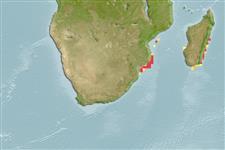分類 / Names
共通名の | 類義語 | Catalog of Fishes(部類, 種) | ITIS | CoL | WoRMS | Cloffa
板鰓亜鋼(サメとエイ類) (sharks and rays) >
Carcharhiniformes (Ground sharks) >
Scyliorhinidae (Cat sharks) > Scyliorhininae
Etymology: Cephaloscyllium: cephalus, from kephale (Gr.), head, referring to its very broad and depressed head; skylion, Greek for dogfish or small shark. (See ETYFish); sufflans: Latin for puffing, referring to its inflatable stomach. (See ETYFish).
More on author: Regan.
Environment: milieu / climate zone / depth range / distribution range
生態学
海 底生の; 深さの範囲 40 - 600 m (Ref. 5578). Tropical; 19°S - 28°S
Western Indian Ocean: Mozambique and Natal, South Africa (Ref. 244). Records from the Gulf of Aden are doubtful. Nominal records from Viet Nam were based on an undescribed species often called Cephaloscyllium umbratile which was not even that species.
サイズ / 重さ / 年齢
Maturity: Lm ? range ? - 82 cm
Max length : 110 cm TL オス/雌雄の選別がない; (Ref. 5578)
簡単な記述
形態学 | 形態計測学
背面の脊椎 (合計): 0; 背鰭 (合計): 0; 肛門の骨 0; 臀鰭: 0. A comparatively large, stout catshark with a broad, rounded snout and no labial furrows; 2nd dorsal much smaller than 1st (Ref. 5578). Pale grey-brown, paler below; juveniles with about 6 slightly darker saddles on the dorsal side which fade and become unmarked in adults (Ref. 5510).
Found on the continental shelf and upper slope, preferring areas with sand and mud bottoms (Ref. 5578). Feeds on benthic animals, mainly crustaceans and cephalopods, but also bony fishes, and other elasmobranches (Ref. 244). Oviparous (Ref. 50449). Can expand with air when disturbed (Ref. 244).
Life cycle and mating behavior
成熟 | 繁殖 | 放精 | 卵 | 生産力 | 幼生
Oviparous, laying one egg-case per oviduct (Ref. 244). Embryos feed solely on yolk (Ref. 50449).
Compagno, L.J.V., 1984. FAO Species Catalogue. Vol. 4. Sharks of the world. An annotated and illustrated catalogue of shark species known to date. Part 2 - Carcharhiniformes. FAO Fish. Synop. 125(4/2):251-655. Rome: FAO. (Ref. 244)
Human uses
水産業: 興味がない
より多くの情報
Age/Size成長体長-重さLength-length体長組成形態計測学形態学幼生幼生の動力補充豊度BRUVS
参考文献水産養殖水産養殖の紹介緊張遺伝子のElectrophoreses遺伝病気行列NutrientsMass conversion
協力者画像Stamps, Coins Misc.音シガテラ(食中毒の名前)速度泳ぐ 型式カマOtoliths脳視覚
用具
特記事項
XMLをダウンロードして下さい
インターネットの情報源
Estimates based on models
Preferred temperature (Ref.
123201): 14.4 - 19.2, mean 15.9 °C (based on 17 cells).
Phylogenetic diversity index (Ref.
82804): PD
50 = 0.5000 [Uniqueness, from 0.5 = low to 2.0 = high].
Bayesian length-weight: a=0.00263 (0.00139 - 0.00497), b=3.21 (3.04 - 3.38), in cm total length, based on LWR estimates for this (Sub)family-body shape (Ref.
93245).
栄養段階 (Ref.
69278): 4.2 ±0.61 se; based on food items.
回復力 (Ref.
120179): 低い, 4.5年~14年の倍増期間の最小個体群 (Fec assumed to be <100).
Fishing Vulnerability (Ref.
59153): High to very high vulnerability (66 of 100).
